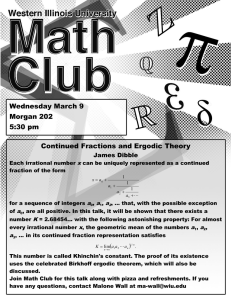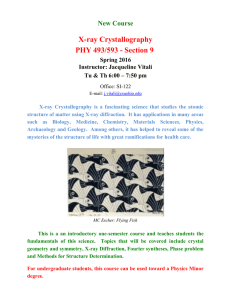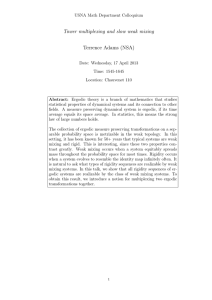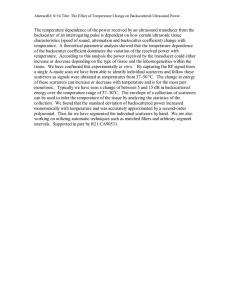Spectral theory and x-ray diffraction
advertisement
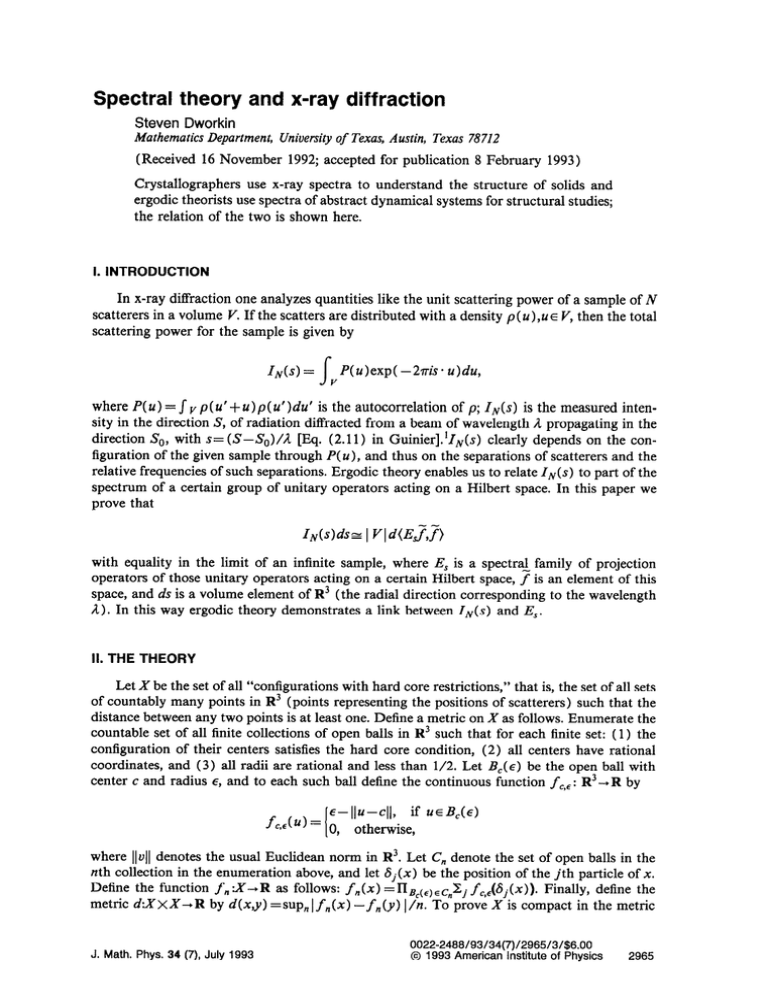
Spectral theory and x-ray diffraction
Steven Dworkin
Mathematics Department, University of Texas, Austin, Texas 78712
(Received 16 November 1992; accepted for publication 8 February 1993)
Crystallographers use x-ray spectra to understand the structure of solids and
ergodic theorists use spectra of abstract dynamical systems for structural studies;
the relation of the two is shown here.
I. INTRODUCTION
In x-ray diffraction one analyzes quantities like the unit scattering power of a sample of N
scatterers in a volume Y. If the scatters are distributed with a density p( U),UE V, then the total
scattering power for the sample is given by
IN(S)
=s
P(u)exp(
-2?ris* u)du,
V
where P(U) = J y p ( U’+ u) p( u’)~u’ is the autocorrelation of p; IN(s) is the measured intensity in the direction S, of radiation diffracted from a beam of wavelength A propagating in the
direction Sc, with s= (S-&,)/A
[Eq. (2.11) in Guinier].‘1&)
clearly depends on the configuration of the given sample through P(U), and thus on the separations of scatterers and the
relative frequencies of such separations. Ergodic theory enables us to relate IN(s) to part of the
spectrum of a certain group of unitary operators acting on a Hilbert space. In this paper we
prove that
I,(s)dss
1 Vld(EJ,f)
with equality in the limit of an infinite sample, where ES is a spectral family of projection
operators of those unitary operators acting on a certain Hilbert space, f is an element of this
space, and ds is a volume element of R3 (the radial direction corresponding to the wavelength
A). In this way ergodic theory demonstrates a link between IN(s) and ES.
II. THE THEORY
Let X be the set of all “configurations with hard core restrictions,” that is, the set of all sets
of countably many points in R3 (points representing the positions of scatterers) such that the
distance between any two points is at least one. Define a metric on X as follows. Enumerate the
countable set of all finite collections of open balls in R3 such that for each finite set: ( 1) the
configuration of their centers satisfies the hard core condition, (2) all centers have rational
coordinates, and (3) all radii are rational and less than l/2. Let B,(E) be the open ball with
center c and radius E, and to each such ball define the continuous function f=,,: R3-+R by
E- IIU-CII, if uEB,(e)
fC,E(U) = 0, otherwise,
I
where ]]u]] denotes the usual Euclidean norm in R3. Let C,, denote the set of open balls in the
nth collection in the enumeration above, and let Sj(X) be the position of the jth particle of x.
Define the function f,, Z+R
as follows: fn(x) =II B=(~)Ec,xj fJSj (X 1I* Finally, define the
metric &XxX-R
by d(x,y) =supn]fn(x)
-f,(r)
I/n. T o p rove X is compact in the metric
J. Math. Phys. 34 (7), July 1993
0022-2488/93/34(7)/2965/3/$6.00
@ 1993 American Institute of Physics
2965
2966
Steven Dworkin: Spectral theory and x-ray diffraction
topology one need only show it has the property that any sequence of configurations has a
subsequence which converges.2 This is straightforward using Cantor diagonalization and the
Bolanzo-Weierstrass theorem applied to bounded cubes, as follows.
Lemma: The space X is compact.
Proof Given a configuration x&Y we may enumerate the points of x as follows. Form a
lattice in R3 from the vectors n,(l/&O,O),
n,(O,l/&O),
n,(O,O,l/$),
where nl,n2,n3EZ.
Enumerate the corresponding lattice boxes {(u, ,u2,u3) ERR ) l/ &zi<ui<
l/ @(ni+ l),
i= 1,2,3} so as to spiral outward from the origin. Then in each copy (translate) of the halfopen-half-closed box [O,l/ &) x [O,l/ 6) x [O,l/ 6) there exists at most one point of the
configuration x (by hard core condition). Define x ( j ) as the position of the particle of x in jth
={q} if no such particle exists]. Let Bj be the closure of Bj and assign
box, ~j [let x(j)
Bi = BjU {q) the usual product topology. Let xi, i) 1, be any sequence of configurations in X.
Then Xi( 1) is a sequence in B, . By the Bolanzo-Weierstrass theorem2 there exists a convergent
subsequence, xj, such that xi ( 1) +x1 EBB as i + to. Again by the Bolanzo-Weierstrass theorem
we may take a subsequence of xf, call it xf, such that x:(j) -+x’EB~, for j = 1,2 as i+ ~0.
Continuing in this way we obtain subsequences xy such that xy( j) +xJeBj for j= l,...,m as
i-+ CO.Taking the diagonal subsequence x: we have that xl( j ) +xieBj
for all j as m --+~0.
Note this gives rise to an allowed configuration x= {xj 1j> 1) (that is, the hard core condition
is satisfied by the collection of points xi,& 1). The fact that x: +x in the metric on X follows
simply.
Q.E.D.
Consider the group of translations of R3 acting on X in the usual way: that is, every particle
of a given configuration is translated by t; we denote this translation of x by t(x) for all
x&Y,tER3. Since X is compact and {t I &R3} is a group of commuting homeomorphisms on X,
there exists a Bore1 probability measure p on X invariant under t for all tER3 (MarkovKakutani theorem).3 We assume the action is ergodic, that is, t(A) =A for all tER3 implies
p (A ) =0 or 1. Let L = L2(X,p) be the Hilbert space of complex valued functions on X which
are square integrable with respect to p. Define the group of unitary operators {T’I tcR3) on L
by [T’(f)](x)
=f[t(x>].
Let S(x) eR3 be any point in the configuration x closest to the origin,
and for each f:R3 -+ R define f(x) =A-6(x)].
Take f to be any positive, real valued function
on R3 such that: supp( f) C BO(~) (that is, f =0 outside a ball of radius E centered at the
origin), and JBOcE)f2(s)ds=1. {For example, we may take f to be the constant function
l/vol[Be( E)] on Bo(E), 0 otherwise.} Furthermore suppose E> 0 is sufficiently small (e.g.,
E < l/2) such that given any x~X there exists ,at most one point of x contained in B,(E). It
where Sj(x) =position
then follows from the hard core condition that f(x) =Bj;rlf[-Sj(x)],
of jth particle of x. Thus
T”?(X)
=
C
j>l
f [S--Sj(X)]e
(1)
Consider the quantity:
W.?,y,f)= s, [Tf~(-dl[f(-W,W)
which by Birkhofl’s
(2)
pointwise ergodic theorem4 satisfies, for p-almost every x~X,
--
Wf,f)=;+m(y(
1
s
vlT’+Uf(~)l[TVf(x)ldu
and so,
J. Math. Phys., Vol. 34, No. 7, July 1993
(3)
2967
Steven Dworkin: Spectral theory and x-ray diffraction
--
( T’f,f >= ;+$ &
Alternately,
from Naimark’s
s
y ~f~r+u~S,~x~lf~u~Sj~x~ldu~
(4)
generalization of Stone’s theorem5 we know that
( T’?,,f>
= JR3exp(LZrs*
f)d(E2,7),
where ES:L + L is a spectral family of operators corresponding to the group of operators
{T’] teR3}. Now if we have N identical scatterers, centered at N points Sj(x) in the configuration x of (4) which are in a volume V, each scatterer represented, not by a delta-function
mass (or charge), but a mass (charge) distributed by a density flu - Sj (x)], they produce a
total intensity IN which satisfies [taking the inverse Fourier transform of Eq. (2.11) in
Guinier], ’
s
v zf
[f+u-Sj(x)
If [U-Sk(X) ldu= J R3 exp(i27rs. t)l,(s)&
Comparing Eqs. (4), (5), and (6) we have that
IN(S)
lim 7
N-m
where I V. I = V/N=average
mately:
volume available to a scatterer. Alternately
I,(s)dsr
Ill. CONCLUDING
(7)
ds= I vo I dWs.?,h
we have approxi-
I F’jd(Ez,f).
(8)
REMARKS
It is perhaps useful to mention the observation motivating the application of ergodic theory
to the study of the unit scattering power. Consideration of the quantity (T’S,f) was central to
the +ve
development and arose quite naturally in the context of averaging. By Eq. (4),
( T’f, f) is related to the separation of scatterers as can readily be seen in the case where f is
uniformly supported over the ball of radius E [that is, f(u) = l/vol[B,( E)] for UE Bo( E), 0
otherwise]. In this case when XLY is a lattice (as in the case of a simple crystal) and t=Sj(x)
-Sk(x) is a lattice vector, then (T’T,f) is the density of pairs separated by the vector t. If t’ G t
(say ]]t’- tll < 2~) then (T”f,y>
will be nonzero, so indeed this quantity is related to the
densities of pair separations.
It is hoped that the interplay between the two spectra will be of use to both crystallographers and ergodic theorists.
ACKNOWLEDGMENTS
I would like to thank C. Radin and M. Senechal for part of the above analysis.
The work was partly supported by Texas ARP Grant No. 003658-113.
’A.
‘H.
‘M.
‘N.
‘F.
Guinier, X-Ray D@iaction (Freeman, San Francisco, 1963).
L. Royden, Real Analysis, 2nd ed. (Macmillan, New York, 1968).
Reed and B. Simon, Methods of Modern Mathematical Physics (Academic, New York, 1972).
Wiener, Duke Math. J. 5, 1 (1939).
Riesz and B. Sz.-Nagy, Functional Analysis, 2nd ed. (Frederick Ungar, New York, 1955), Sec. 140, p. 392.
J. Math. Phys., Vol. 34, No. 7, July 1993
